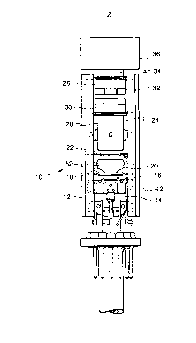Some of the information on this Web page has been provided by external sources. The Government of Canada is not responsible for the accuracy, reliability or currency of the information supplied by external sources. Users wishing to rely upon this information should consult directly with the source of the information. Content provided by external sources is not subject to official languages, privacy and accessibility requirements.
Any discrepancies in the text and image of the Claims and Abstract are due to differing posting times. Text of the Claims and Abstract are posted:
| (12) Patent: | (11) CA 2156323 |
|---|---|
| (54) English Title: | INLINE ELECTRON GUN HAVING IMPROVED BEAM FORMING REGION |
| (54) French Title: | CANON ELECTRONIQUE DE TYPE IN-LINE A REGION DE MISE EN FORME DE FAISCEAUX AMELIOREE |
| Status: | Expired and beyond the Period of Reversal |
| (51) International Patent Classification (IPC): |
|
|---|---|
| (72) Inventors : |
|
| (73) Owners : |
|
| (71) Applicants : |
|
| (74) Agent: | CRAIG WILSON AND COMPANY |
| (74) Associate agent: | |
| (45) Issued: | 2000-01-25 |
| (22) Filed Date: | 1995-08-17 |
| (41) Open to Public Inspection: | 1996-02-27 |
| Examination requested: | 1995-08-17 |
| Availability of licence: | N/A |
| Dedicated to the Public: | N/A |
| (25) Language of filing: | English |
| Patent Cooperation Treaty (PCT): | No |
|---|
| (30) Application Priority Data: | ||||||
|---|---|---|---|---|---|---|
|
An improved inline electron gun includes a plurality of
electrodes spaced from three cathodes in the direction of a
longitudinal axis of the gun. The electrodes form at least a beam
forming region and a main focus lens in the paths of three
electron beams, a center beam and two side beams. Each of the
electrodes includes three inline apertures therein for passage of
the three electron beams. The beam forming region includes the
cathodes and three consecutive electrodes, a G1 electrode, a G2
electrode and a G3 electrode. The improvement comprises the G2
electrode having two linear projections on either side of the inline
apertures therein. The projections parallel the inline direction of
the apertures protrude in a direction parallel to the longitudinal
axis, past the apertured portion of the G3 electrode in overlapping
relationship therewith. On the side of the G3 electrode facing the
G2 electrode, the G3 electrode has two linear channels therein on
either side of the inline apertures therein. The channels are
immediately adjacent the projections on the G2 electrode and in a
spaced nested relationship therewith.
Note: Claims are shown in the official language in which they were submitted.
Note: Descriptions are shown in the official language in which they were submitted.

2024-08-01:As part of the Next Generation Patents (NGP) transition, the Canadian Patents Database (CPD) now contains a more detailed Event History, which replicates the Event Log of our new back-office solution.
Please note that "Inactive:" events refers to events no longer in use in our new back-office solution.
For a clearer understanding of the status of the application/patent presented on this page, the site Disclaimer , as well as the definitions for Patent , Event History , Maintenance Fee and Payment History should be consulted.
| Description | Date |
|---|---|
| Time Limit for Reversal Expired | 2010-08-17 |
| Letter Sent | 2009-08-17 |
| Grant by Issuance | 2000-01-25 |
| Inactive: Cover page published | 2000-01-24 |
| Inactive: Final fee received | 1999-10-21 |
| Pre-grant | 1999-10-21 |
| Notice of Allowance is Issued | 1999-05-12 |
| Notice of Allowance is Issued | 1999-05-12 |
| Letter Sent | 1999-05-12 |
| Inactive: Status info is complete as of Log entry date | 1999-05-10 |
| Inactive: Application prosecuted on TS as of Log entry date | 1999-05-10 |
| Inactive: Approved for allowance (AFA) | 1999-04-14 |
| Inactive: Office letter | 1998-09-29 |
| Inactive: Delete abandonment | 1998-09-28 |
| Deemed Abandoned - Failure to Respond to Maintenance Fee Notice | 1998-08-17 |
| Application Published (Open to Public Inspection) | 1996-02-27 |
| All Requirements for Examination Determined Compliant | 1995-08-17 |
| Request for Examination Requirements Determined Compliant | 1995-08-17 |
| Abandonment Date | Reason | Reinstatement Date |
|---|---|---|
| 1998-08-17 |
The last payment was received on 1999-07-29
Note : If the full payment has not been received on or before the date indicated, a further fee may be required which may be one of the following
Please refer to the CIPO Patent Fees web page to see all current fee amounts.
| Fee Type | Anniversary Year | Due Date | Paid Date |
|---|---|---|---|
| MF (application, 2nd anniv.) - standard | 02 | 1997-08-18 | 1997-07-24 |
| MF (application, 3rd anniv.) - standard | 03 | 1998-08-17 | 1998-07-22 |
| MF (application, 4th anniv.) - standard | 04 | 1999-08-17 | 1999-07-29 |
| Final fee - standard | 1999-10-21 | ||
| MF (patent, 5th anniv.) - standard | 2000-08-17 | 2000-06-29 | |
| MF (patent, 6th anniv.) - standard | 2001-08-17 | 2001-07-10 | |
| MF (patent, 7th anniv.) - standard | 2002-08-19 | 2002-07-12 | |
| MF (patent, 8th anniv.) - standard | 2003-08-18 | 2003-07-11 | |
| MF (patent, 9th anniv.) - standard | 2004-08-17 | 2004-07-29 | |
| MF (patent, 10th anniv.) - standard | 2005-08-17 | 2005-07-08 | |
| MF (patent, 11th anniv.) - standard | 2006-08-17 | 2006-07-17 | |
| MF (patent, 12th anniv.) - standard | 2007-08-17 | 2007-07-06 | |
| MF (patent, 13th anniv.) - standard | 2008-08-18 | 2008-07-10 |
Note: Records showing the ownership history in alphabetical order.
| Current Owners on Record |
|---|
| THOMSON TUBES AND DISPLAYS, S.A. |
| Past Owners on Record |
|---|
| RODOLPHE LAUZIER |
| YVES PONTAILLIER |